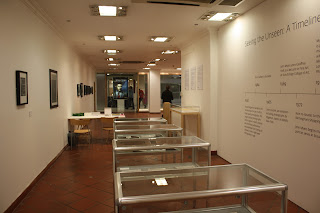During the summer, I went to see an exhibition of Harold E Edgerton's best work called Seeing the Unseen:Photographs and Films by Harold E Edgerton. The purpose of the this exhibition was to celebrateEdgerton's work.
Harold Edgerton used photography primarily as a tool for his work as scientist, engineer, teacher and inventor. He invented a high-speed photographic process with stoboscopic instances of light or 'flash' to create a multi-exposure effect. This invention helped him capture movement.
Location
The exhibition was situated at a shopping unit in the Pallasades Shopping Centre in Birmingham. The shop unit was bought by Ikon Gallery, who organised the exhibition. I found it fairly easy to find as it was so close to the train station, but there wasn't much in terms of directions.
Advertising
I found out about the exhibition by searching on the Ikon gallery website. On there, it gaves details of dates but was very vague about directions. Other than that, the exhibition was fairly poorly advertised. There was only one poster advertising the exhibition which was situated by the train station, coming out into the Pallasade's shopping centre. Even then, it didn't give much information as to where the exhibition was located. As I frequently go to Birmingham, I have a vague idea of where things are and I used my previous knowledge to find the exhibition. For someone who wasn't familiar with Birmingham, getting to the exhibition would have been a problem.
The exhibition design allowed a clear navigation for the viewers. As the door was to the right of the unit, we were navigated to the right wall with photographic prints displayed on the wall. The seating area works almost like a barrier, preventing you from going to the left side of the room, navigating you anti-clockwise around the room. Also, when I entered, I was drawn to the back of the room which displays many pieces in glass cabinets. The exhibition design does cater for wheelchairs and pushchairs until you get to the glass cabinets where there is very little spare room as well as going through the doorway to where the film is displayed. There is also a seating area in the exhibition room as well as toilets and cafes within the shopping centre.
The Works
The works mainly consist of photographs mounted in same size frames, which create a neat and cohesive look. They are attached to the wall with screws. They are displayed in their series, making the pieces flow more, creating almost a narrative. The problem with the presentation of these works was that the lighting glared off the gloss prints, which made it difficult to appreciate the prints fully as you could see your own reflection in the work.
Written Material
There was an array of written material available at the exhibition. There was atimeline on the wall, giving more detail on Edgerton's life. As well as this, there were three mounted posters on the wall, giving more information on the Ikon Gallery and events. Also, each piece had a label with the artist, title, dates and materials used for each piece. I was also given a leaflet from a memeber of staff, giving a general overview of the exhibition. There were also books available to buy, giving greater detail about his works.
I had a friendly welcome when I entered the exhibition space and was given a general overview of the exhibition. As the exhibition wasn't very busy, there was onl me as a viewer, which made the experience feel rushed, like I was in the way. I felt to achieve the purpose of the exhibition, the space needed to be larger, allowing larger prints to be made,therefore allow the viewers to appreciated the intricate details of his work. Also, I think there needed to be more free information available as I found I had to research his work after my visit. It could be argued that the target audience for the exhibition was people who had a sdpecific interest in this area and were already aware of his work, but because of the location, in a shopping centre, I feel that the exhibition was open to the general public and more information should have been available for the work to be appreciated and understood by all.





No comments:
Post a Comment